Ever opened your kitchen cabinets and felt like you’re staring into an abyss of chaos? That moment when the pasta strainer comes crashing down as you reach for a simple drinking glass – we’ve all been there!
Kitchen cabinet organization isn’t just about looking pretty – it’s the secret weapon that converts cooking from frustrating to fantastic.
The magic lies in creating purposeful zones where things logically belong. Smart cabinet zoning respects how you actually move through your kitchen, not how a magazine spread suggests you should.
Ready to end the daily treasure hunt for basic cooking tools? Let’s uncover the power of strategic kitchen cabinet zones that work with your cooking style, not against it.
The 7 Primary Zones for Kitchen Cabinet Storage
Ever walked into your kitchen and felt a strange sense of chaos? That empty feeling when you can’t find the spatula while your eggs are burning? We’ve all been there!
Kitchen organization isn’t just about looking neat – it’s about creating a cooking space that works with you, not against you. Think of your kitchen cabinets as real estate: location matters!
Let’s break down the seven zones that will revolutionize how you use your kitchen space.
1. Everyday Dishes and Utensils
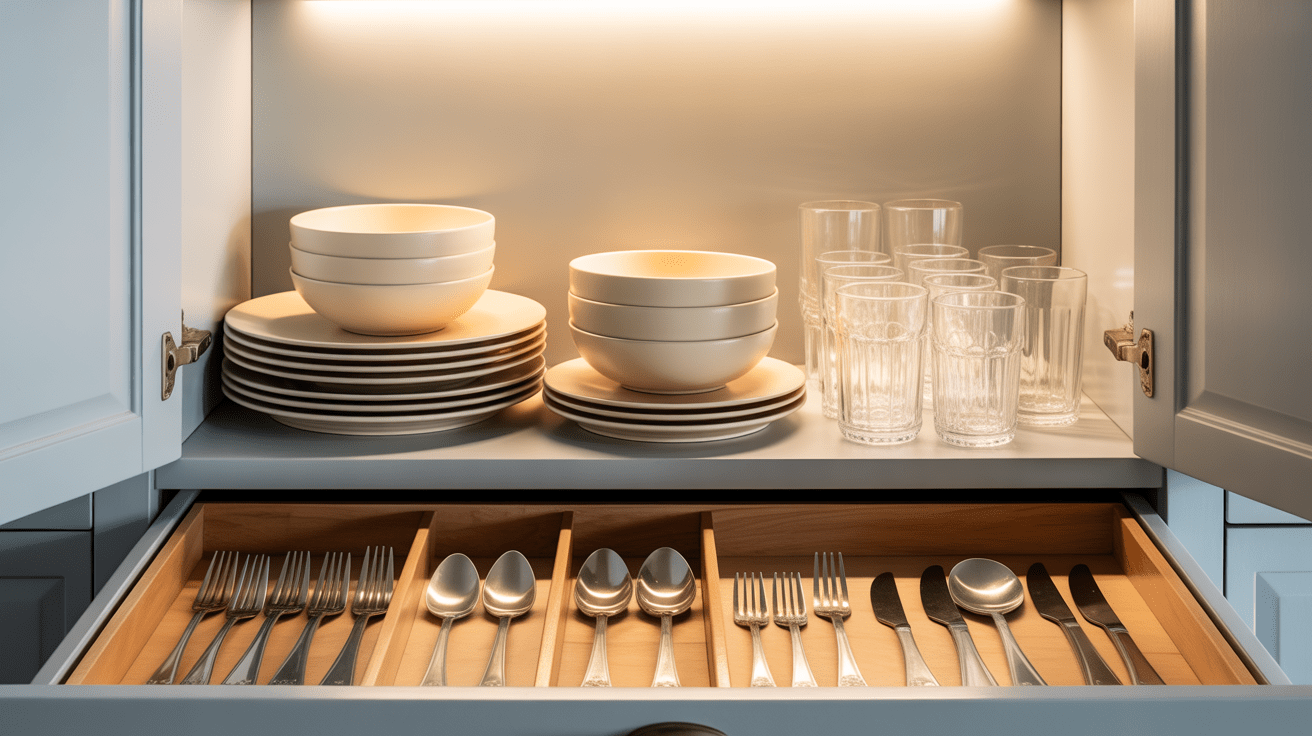
The items you reach for daily deserve prime cabinet real estate. Place them near the dishwasher or sink (on the right side, if possible) for easy access.
What belongs here? Your daily essentials need a dedicated home:
- Plates and bowls for everyday meals
- Silverware and serving utensils
- Glasses and mugs for daily drinks
- Small bowls for snacks and prep
This arrangement speeds up unloading the dishwasher and makes mealtime setup a breeze. No more walking across the kitchen with stacks of plates!
PRO TIP: Reserve the middle shelves at eye-level for these items. Lower shelves work well for kids’ dishes, making them accessible for little helpers.
2. Cooking Tools Zone
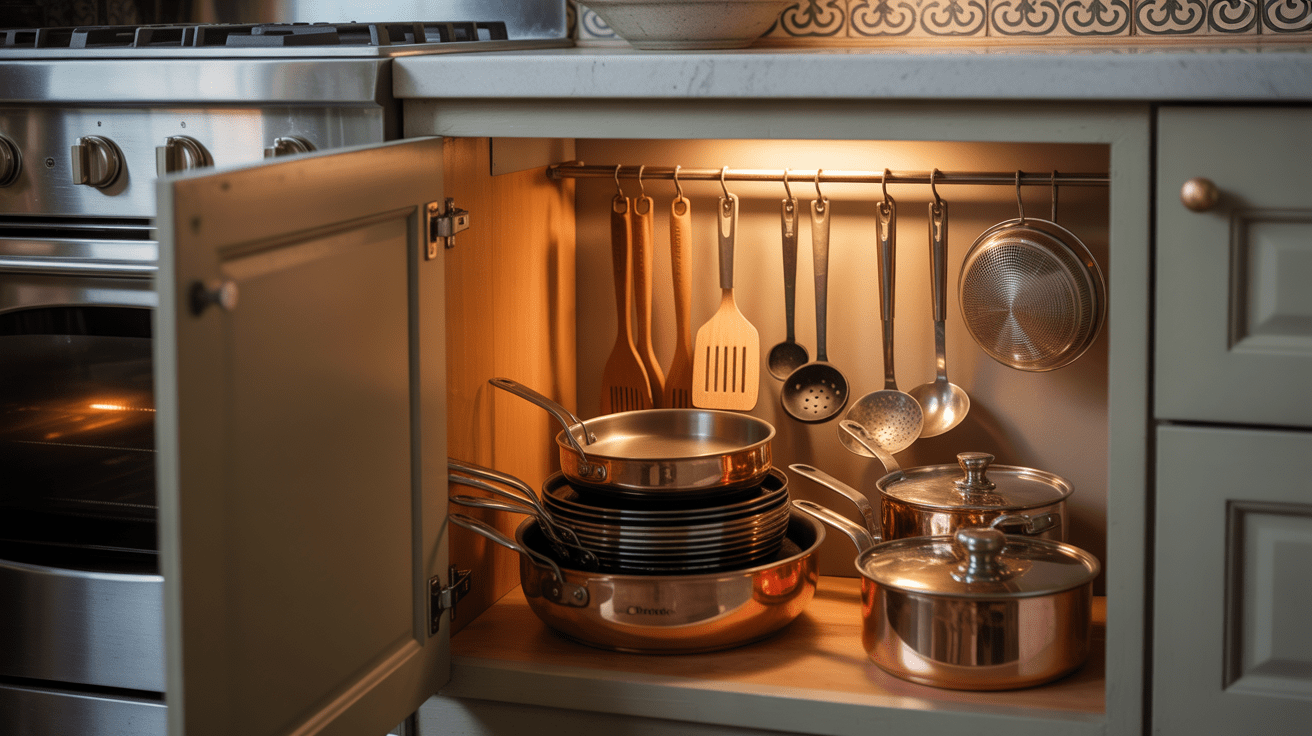
Your cooking station needs backup! This zone works best when positioned right next to your stove (on the right for right-handed cooks).
The perfect cooking zone contains all your hot-food handling heroes:
- Pots and pans of various sizes
- Spatulas, wooden spoons, and tongs
- Potholders and trivets
- Lid organizers to prevent avalanches
Keeping these items close reduces the dance of dodging open drawers while carrying hot pans. Your cooking flow becomes smoother when everything is within arm’s reach.
3. Baking Supplies (Non-Consumables)
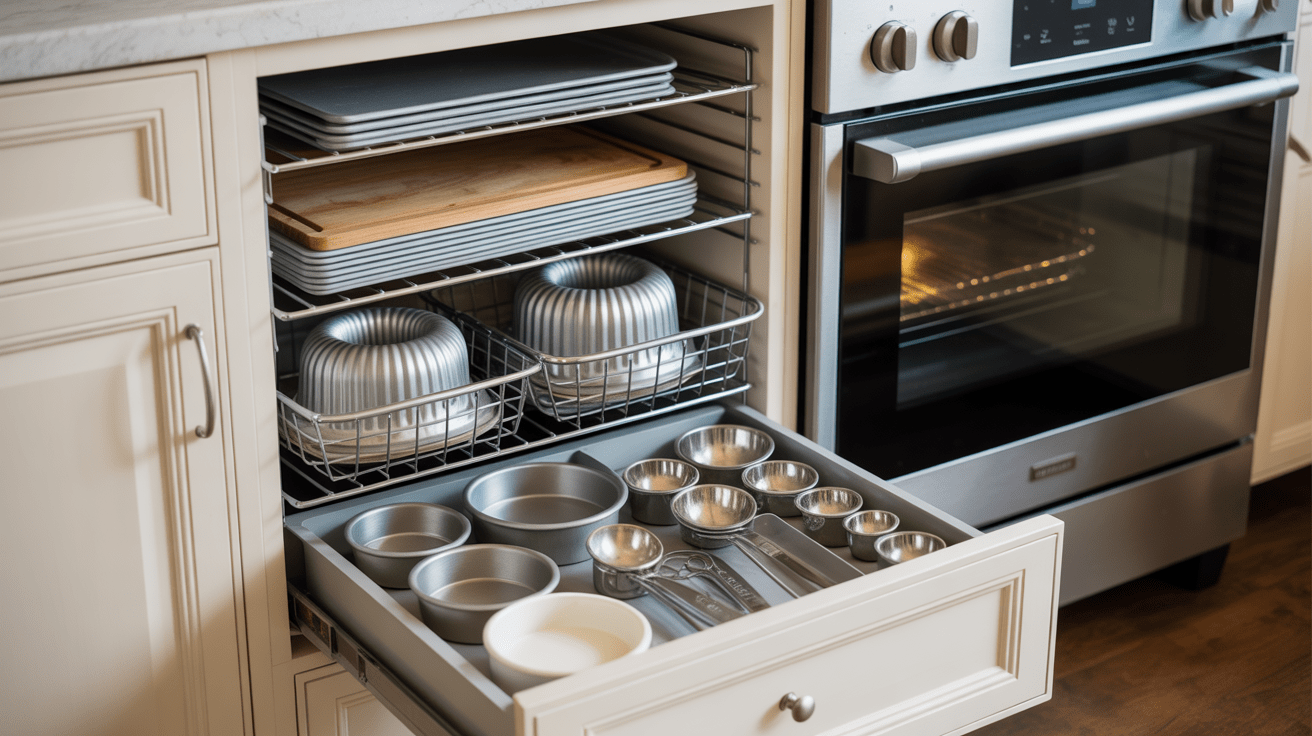
Baking requires special tools, which often have awkward shapes. Store these items close to your oven or designated baking area.
The baking zone needs thoughtful organization since many items don’t stack neatly:
- Vertical dividers work wonders for baking sheets and cutting boards
- Wire baskets can corral oddly shaped bundt pans and springform pans
- Add drawer organizers specifically for measuring cups and spoons
With smart storage solutions, your baking essentials will be organized and easily accessible whenever inspiration strikes!
4. Prep Tools & Meal Prep Essentials
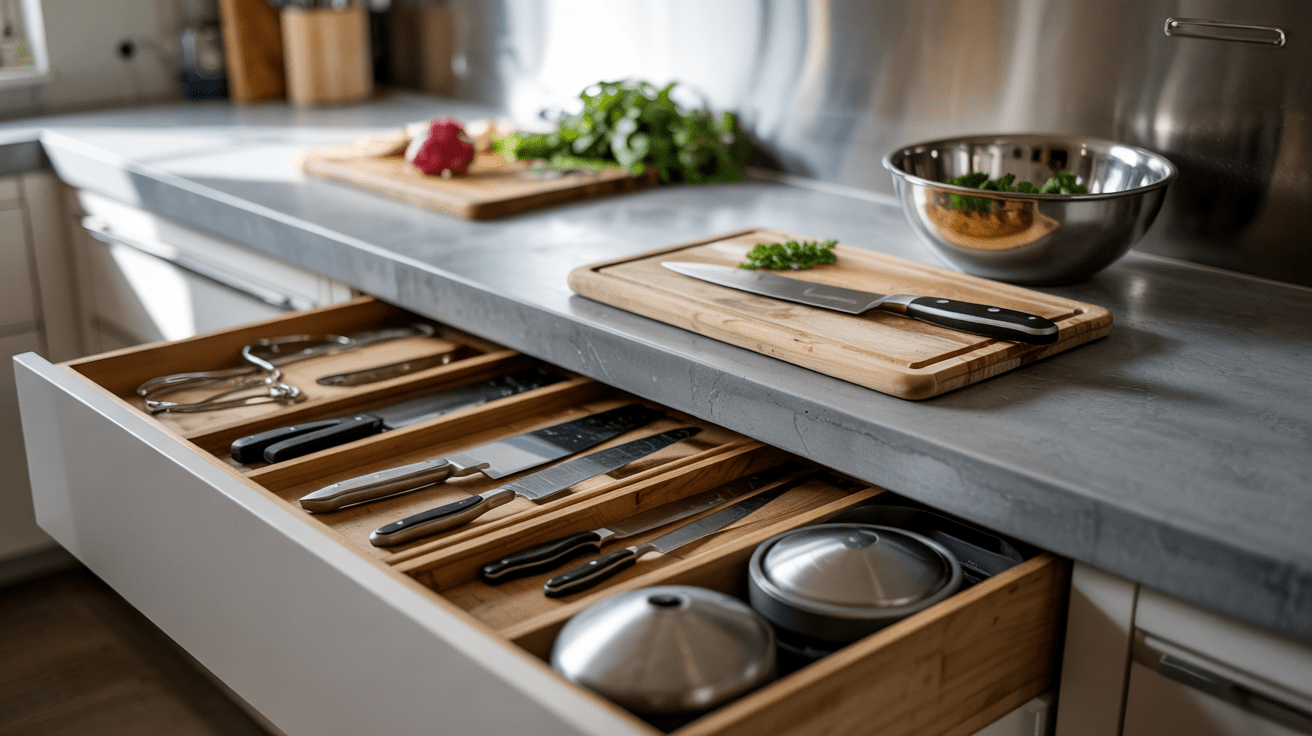
Meal prep happens before cooking begins, so this zone works best near your largest clear countertop area.
Before getting started on any recipe, you’ll need these essential prep items:
- Cutting boards (ideally sorted by use)
- Knives and sharpening tools
- Measuring cups and spoons
- Mixing bowls of various sizes
- Food processors or blenders
Using dividers, hanging racks, and lazy Susans keeps everything visible and accessible. No more digging through drawers while your hands are covered in marinade!
5. Serving & Entertaining Items
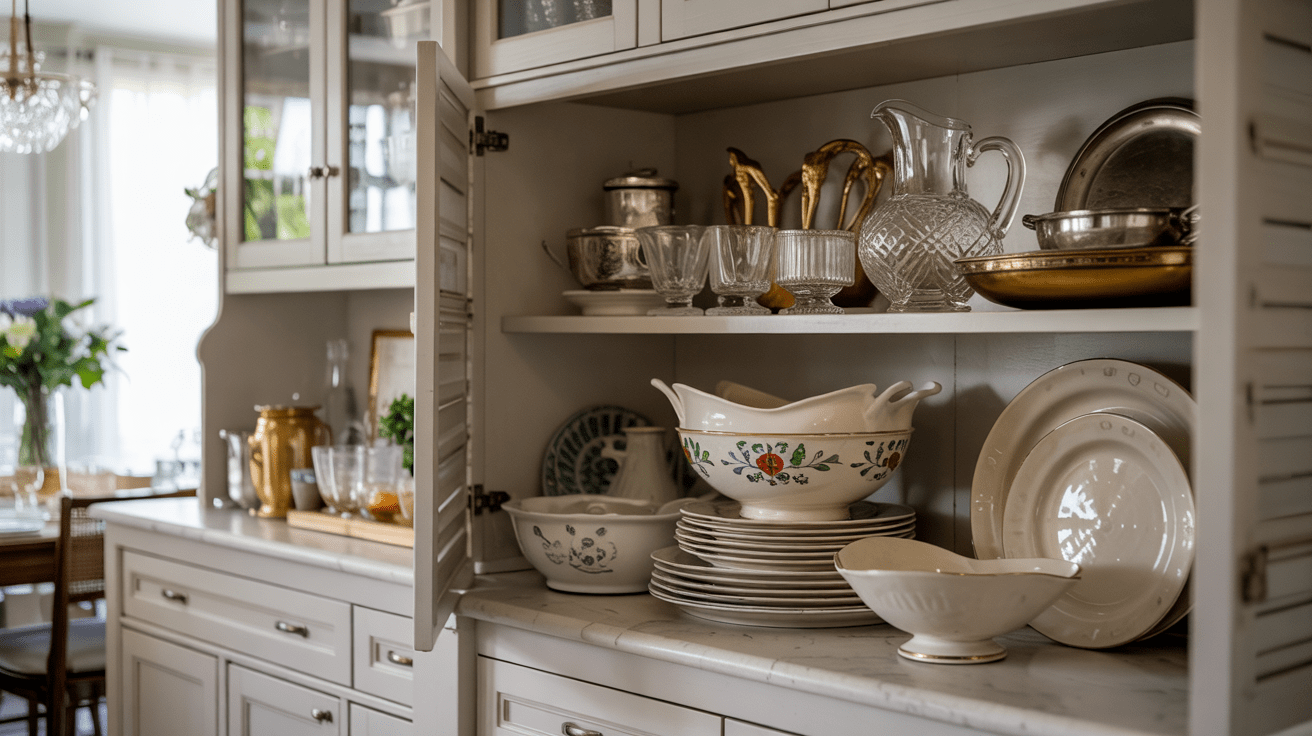
These less-frequently used items deserve their own special zone, ideally away from the busy prep area and closer to your dining space.
Party-ready platters and special occasion items need their own home:
- Large serving platters and bowls
- Pitchers and punch bowls
- Seasonal and holiday-specific dishes
- Special occasion glassware
Since these items are less frequently used, consider storing them in higher or lower cabinets, leaving prime middle-shelf space for everyday essentials.
PRO TIP: Store similar items together with felt protectors between stacked plates to prevent scratches. Take photos of how you arrange special occasion items so you can replicate the setup after the holidays.
6. Food Storage Containers
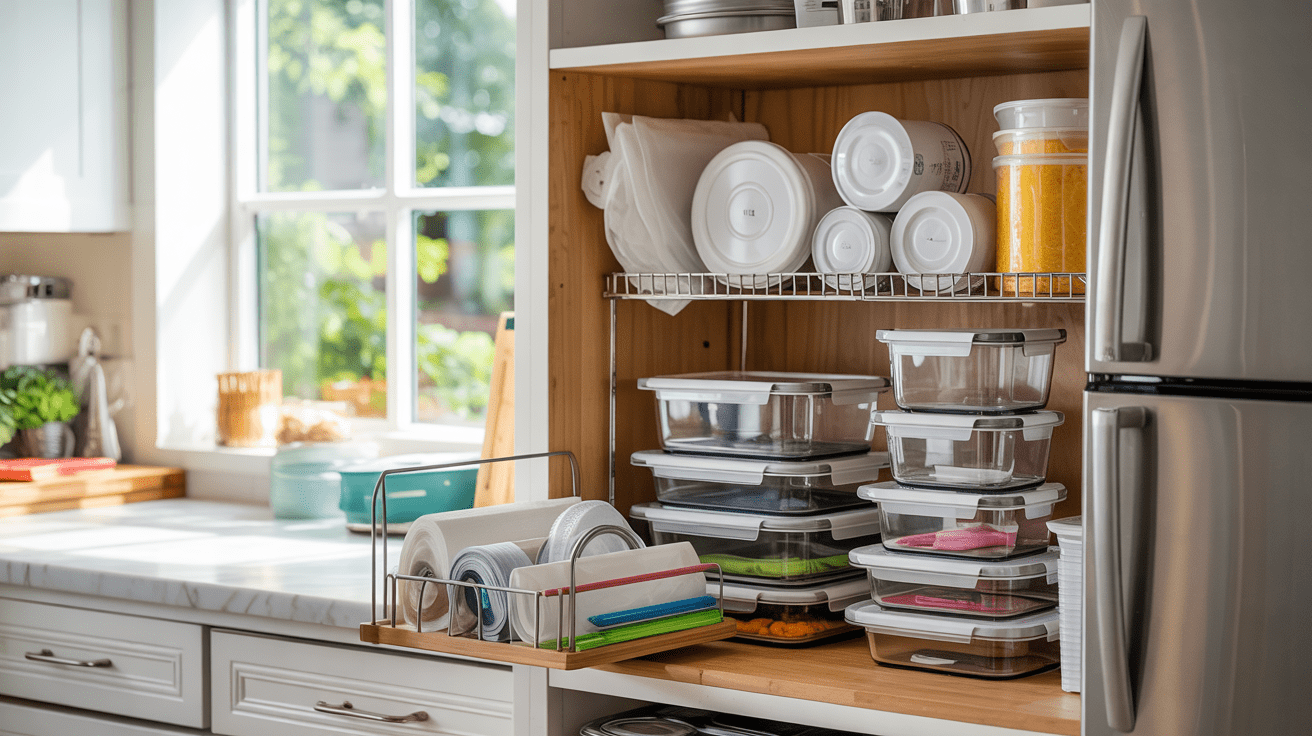
The after-meal cleanup zone works best when positioned near your refrigerator. This area should house all your leftover-saving heroes.
Fresh food deserves proper storage solutions:
- Food containers in various sizes
- Plastic wrap, aluminum foil, and parchment paper
- Bag clips and ties
- Reusable storage bags
Nesting containers with matching lids saves space and sanity. To prevent the dreaded lid avalanche every time you open the cabinet, try storing lids in a separate organizer or file folder.
7. Cleaning Supplies
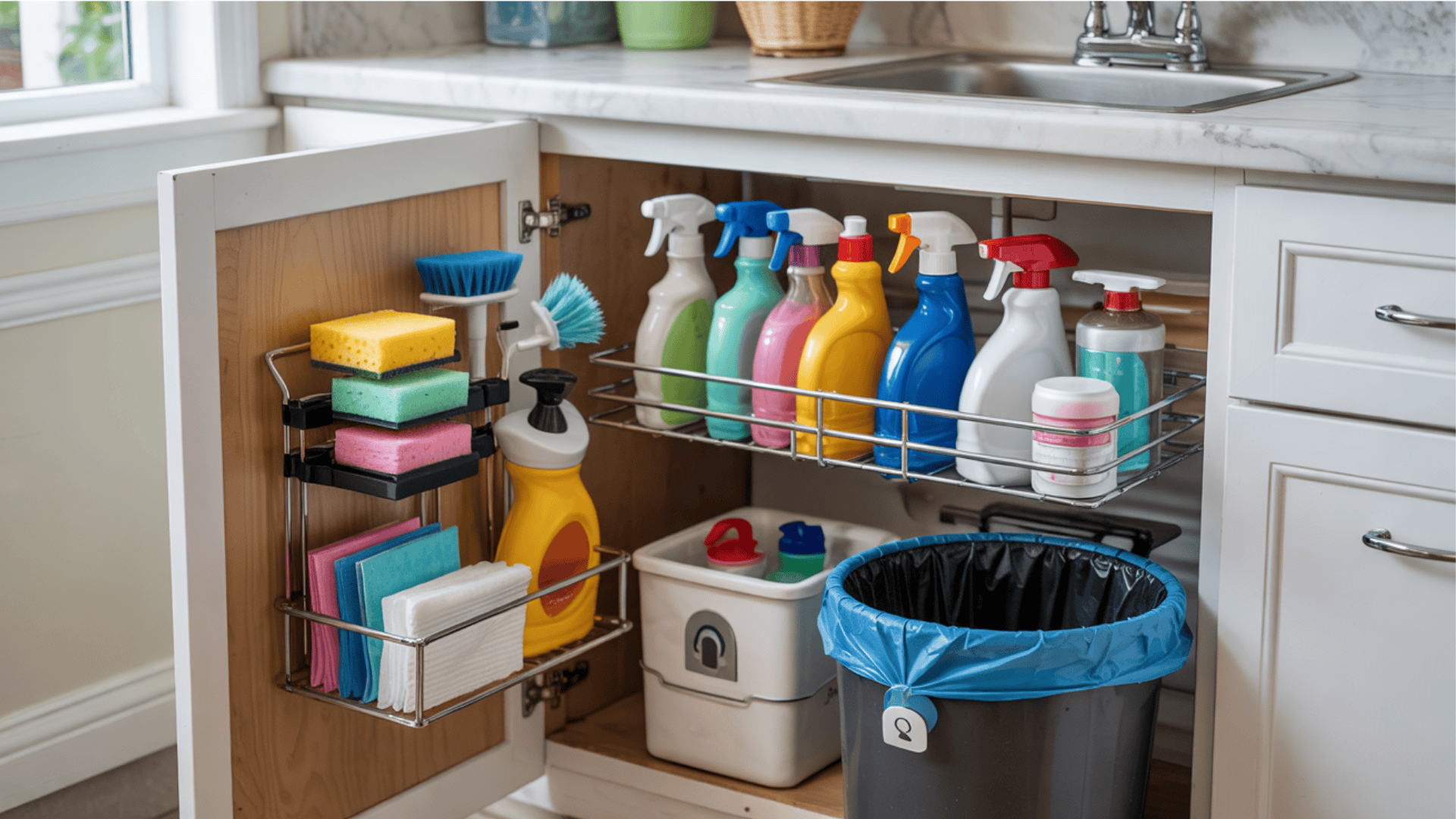
Under-sink storage or an adjacent cabinet makes the perfect home for cleaning essentials. Safety matters here, especially in homes with kids or pets.
The cleaning zone should contain:
- Sponges, brushes, and cleaning cloths
- Dish soap and hand soap refills
- Trash bags and recycling supplies
- Surface cleaners appropriate for your countertops
Use pull-out organizers to make back-of-cabinet items accessible. Consider childproof locks if storing any potentially harmful cleaning products.
Secondary Zones and Custom Station Ideas
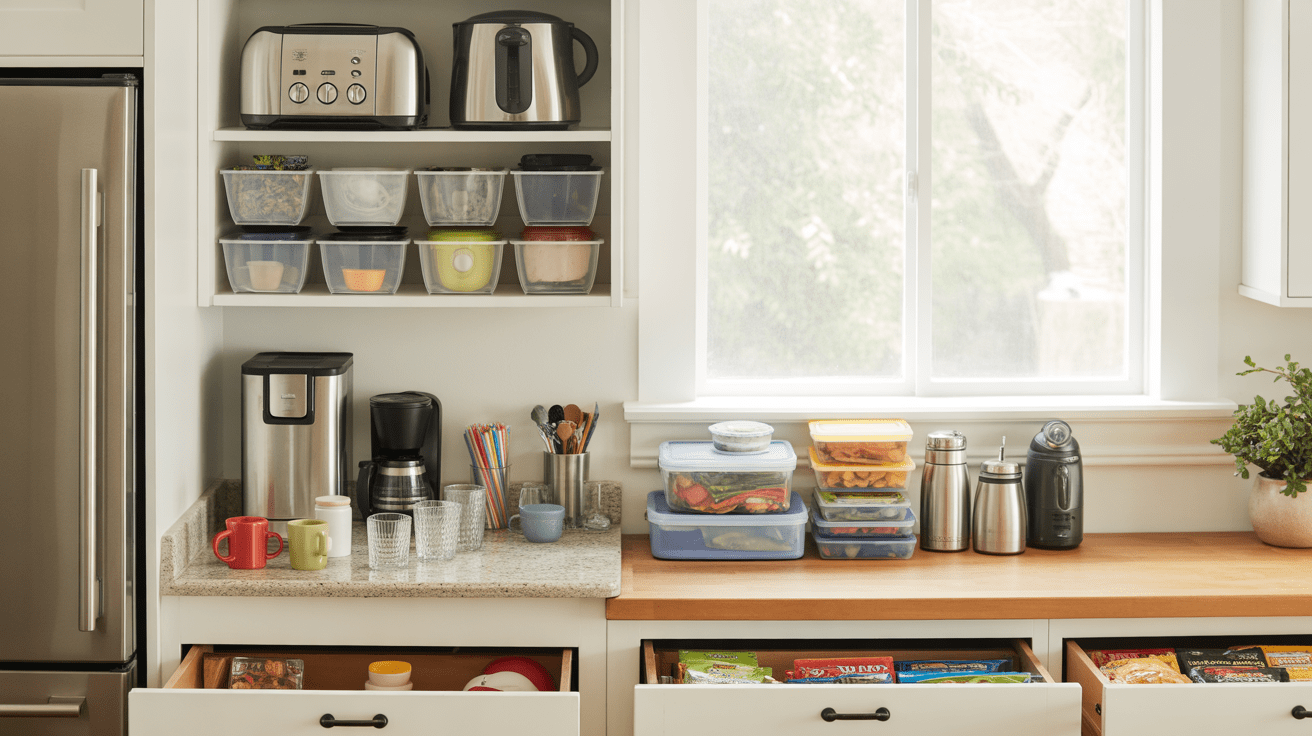
Now that we’ve covered the essentials, let’s get creative! These specialized zones add convenience to your kitchen workflow.
8. Drink Station
Morning coffee? Afternoon tea? Evening cocktails? A dedicated drink zone simplifies your beverage routine.
Position this station between your refrigerator and coffee maker. Stock it with mugs, glasses, tea supplies, and smoothie ingredients. Consider adding a small drawer for drink accessories like straws, stirrers, and cocktail picks.
For coffee enthusiasts, a pull-out shelf can hold your coffee maker, grinder, and favorite beans, creating a mini café right in your kitchen.
9. Lunch Prep Zone
With a dedicated lunch station near your refrigerator and a prep counter, lunch packing for school mornings and workdays becomes less stressful.
This zone streamlines the lunch-making process:
- Food containers in lunch-appropriate sizes
- Lunch bags and ice packs
- Portable cutlery and napkins
- Reusable water bottles
Families with kids can add a lower drawer with approved snack options, allowing children to pack part of their lunch independently.
10. Small Appliances Cabinet
Small appliances can quickly overtake counter space. Create a dedicated cabinet that groups these items logically.
Consider organizing by frequency of use, with daily items (like toasters) at eye level and seasonal items (like ice cream makers) on higher or lower shelves.
Get rid of duplicate appliances and donate those you haven’t used in over a year. For items you keep, store the base and attachments together using clear bins.
How to Set Up Zones in Your Unique Kitchen Layout
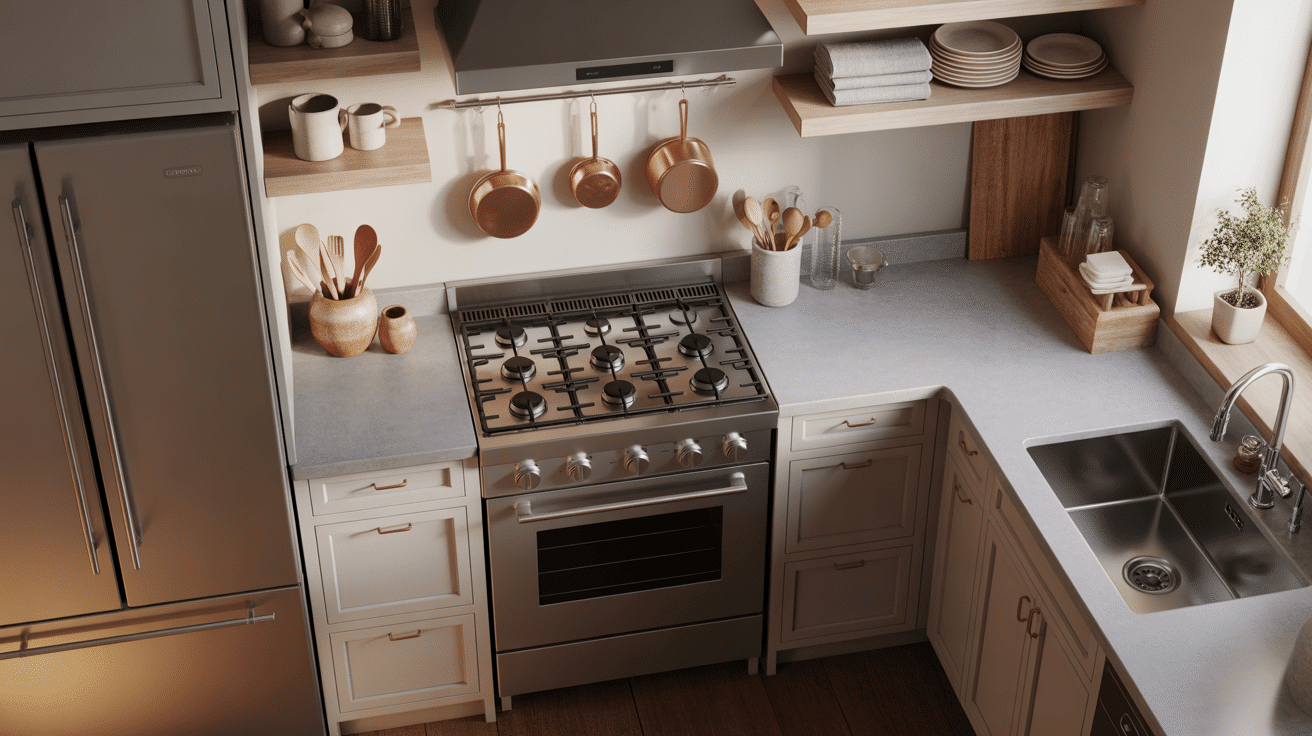
Every kitchen has its own personality! Let’s adapt these zones to fit your specific space.
Step 1 – Identify Your Work Triangle
The kitchen work triangle connects your three busiest areas: sink, stove, and refrigerator. Draw an imaginary line between these points to create a triangle.
The most efficient kitchens keep this triangle compact but not cramped. Once you identify your triangle, you can start planning zones that make sense with your movement patterns.
Step 2 – Label and Visualize
Before moving everything around, test your plan! Use sticky notes to mark where each zone will go.
Walk through common kitchen tasks and note any bottlenecks or awkward transitions. Are high-use items too far from where you need them? Does your plan create traffic jams when multiple people use the kitchen? Make adjustments before the heavy lifting begins.
Step 3 – Prioritize Based on Usage
Not all kitchen items deserve prime real estate. Be honest about what you use daily, weekly, monthly, or yearly.
Items you use daily should sit at eye level and within easy reach. Less frequently used items can go on higher shelves or in deeper cabinets. Seasonal items might even warrant storage outside the kitchen if space is tight.
Applying the 5-Zone Method for Maximum Workflow
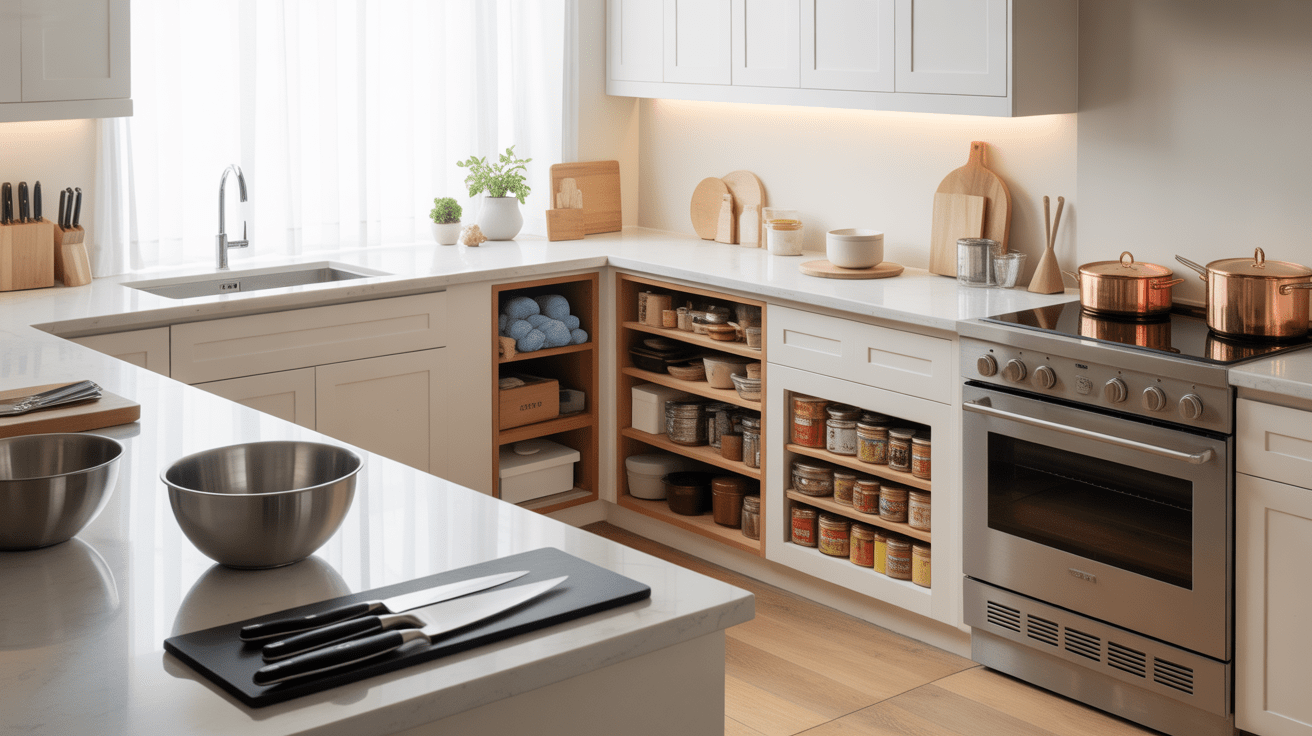
Let’s look at another approach to kitchen organization that complements our 7-zone system.
Overview of the 5-Zone System
The 5-zone system focuses on kitchen activities rather than item types:
- Prep Zone: Where you prepare ingredients
- Cooking Zone: Where heat happens
- Cleaning Zone: Dishwashing and cleanup area
- Consumables Zone: Food storage
- Non-Consumables Zone: Dish and tool storage
This system helps you think about your kitchen in terms of workflow rather than just storage categories.
Mapping 5-Zone Logic to Cabinet Placement
The 5-zone system aligns beautifully with our 7 primary zones. Here’s how they connect:
| 5-Zone System | 7-Zone System |
|---|---|
| Prep Zone | Prep Tools Zone |
| Cooking Zone | Cooking Tools Zone + Baking Supplies |
| Cleaning Zone | Cleaning Supplies |
| Consumables Zone | Food Storage |
| Non-Consumables | Everyday Dishes + Serving Items |
This table illustrates how the two systems complement each other, providing multiple perspectives on your kitchen organization.
Modern Kitchen Adjustments
Today’s kitchens often feature open layouts, islands, and galley designs. Adapt your zones accordingly!
Islands make excellent prep stations with drawers for tools underneath. Open layouts might benefit from concealed storage for less attractive items. Galley kitchens work best with zones on opposite walls to prevent bottlenecks.
Customizing for Small, Medium, and Large Kitchens
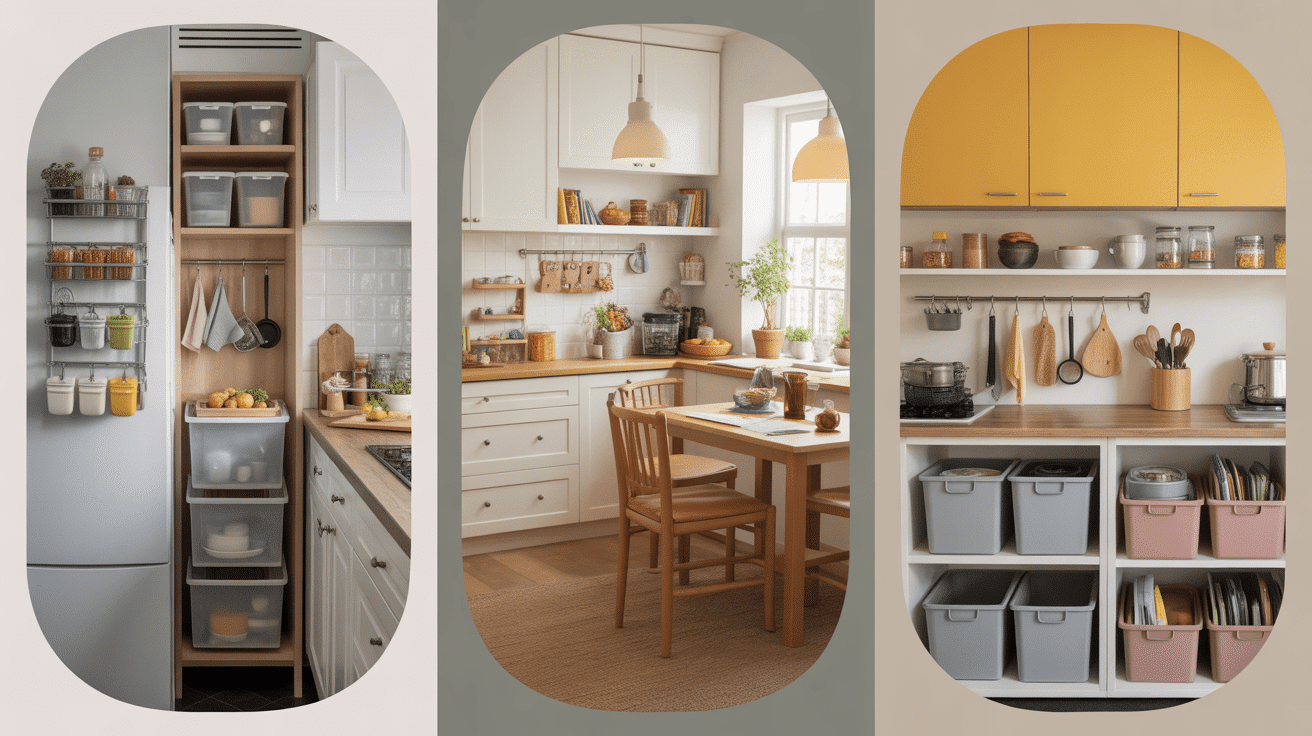
The size of your kitchen influences how you implement these zones. Let’s look at solutions for different spaces.
Small Kitchens
Small kitchens demand creativity! Think vertical with wall-mounted organizers and over-the-door racks.
Invest in stackable, clear containers for maximum visibility in deep cabinets. Multi-purpose tools save precious space – a pressure cooker that also slow cooks eliminates the need for two appliances.
Large Kitchens
Bigger kitchens allow for special interest zones! Consider adding:
- A coffee bar with all supplies in one area
- A baking station with counter space and nearby ingredients
- A homework nook for kids to sit while you cook
- Pet feeding stations in a dedicated cabinet
Large kitchens can still become disorganized, so maintain clear zone boundaries even with extra space.
Shared Kitchens
Roommate situations or multi-generational homes require extra planning and consideration. Establish clear boundaries by using labeled bins for personal items.
Establish “community use” areas for shared basics and personal zones for specialized items. Color-coding can help everyone remember whose stuff is whose!
Tips for Long-Term Maintenance
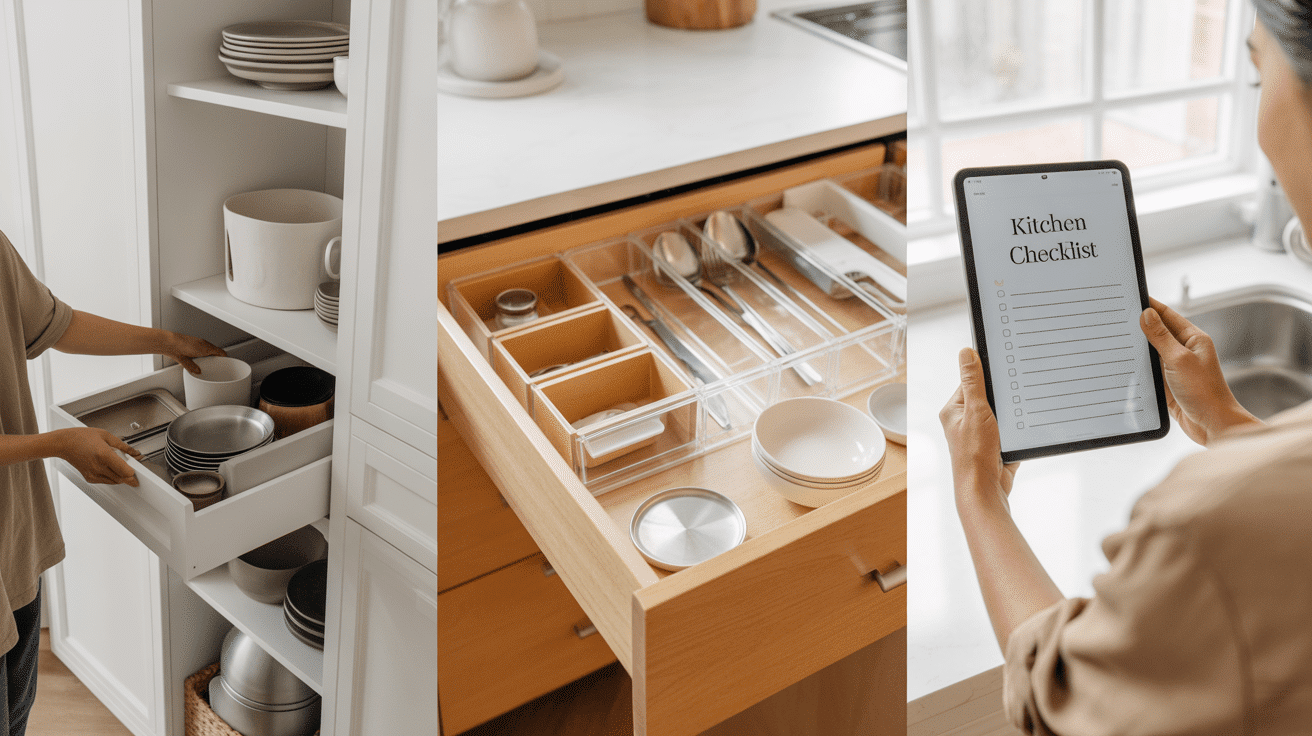
Setting up zones is just the beginning. Keeping them functional takes ongoing effort.
- Declutter First, Then Organize: Never organize clutter! Before establishing zones, be ruthless about what stays and goes. Ask yourself: When did I last use this? Does it have a purpose? Remove broken items, duplicates, and those “someday” gadgets collecting dust.
- Use Drawer Dividers and Cabinet Bins: Organization tools make maintenance easier. Drawer dividers and cabinet bins keep items from migrating where they don’t belong,
- Revisit Your Setup Every 6 Months: Kitchens evolve as your life changes. New hobbies, dietary shifts, and family changes all impact how you use your space.
Schedule a twice-yearly review. Are your zones still working? Has clutter crept back? This regular maintenance keeps your kitchen at peak efficiency.
Last Thoughts
A well-zoned kitchen becomes your silent partner in meal preparation, entertaining, and everyday life. The beauty of cabinet zones is their ability to evolve as your cooking habits change.
Your kitchen should feel intuitive to use, not like a puzzle to solve each time you cook.
When items live where you naturally reach for them, cooking transforms from a chore to a pleasure, cabinet zoning creates a rhythm to your kitchen work – a dance where everything is exactly where your hands expect it to be.
The time you save looking for misplaced items becomes time you can spend enjoying the meals you create and the people you share them with.
Ready to revolutionize your kitchen? Comment below with your biggest cabinet organization challenge, and let’s solve it together!


